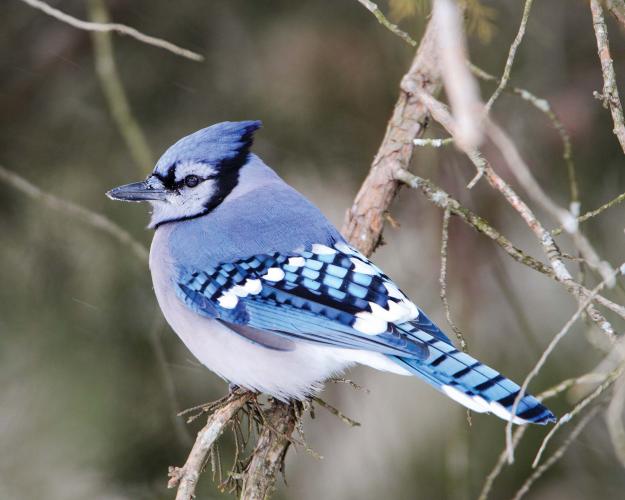Blue Jay
The Blue Jay (Cyanocitta cristata) is one of Missouri’s most attractive and recognizable songbirds, with its powder-blue to periwinkle-blue plumage and soft -gray and white belly. The wings and tail feature brilliant white accents and black laddering. A black bridle about the head and face extends along the nape to the tip of a prominent crest. Although most Missourians take this common bird for granted, think how remarkable a blue jay would appear to somebody who has never seen one.
Blue jays are not the most beloved of birds, as they are oft en aggressive toward other songbirds, especially around feeders. I will admit that I had great disdain for blue jays as a boy growing up in the Missouri Ozarks. Every time I went frog hunting, the local jays began anxiously calling as I neared our pond. I was convinced that they were warning the frogs of my approach. As I grew older, my contempt for blue jays shift ed to respect as I better appreciated their social behavior, such as the mobbing of hawks and owls and their extreme wariness, which makes them one of Missouri’s most difficult birds to photograph.
The blue jay is listed as a common permanent resident throughout Missouri, and it is found in forests, woodlands, parks, and most backyards where trees are present. The blue jay diet consists mostly of acorns, fruits, and seeds, but they may also feed on insects, carrion, and even the eggs and young of nesting songbirds. Blue jays produce a variety of sounds from a loud, raspy “jay” call to piping notes that are very soothing. They oft en mimic the sound of predators to frighten other songbirds away from nests or bird feeders. I have been fooled more than once as a blue jay perfectly mimicked the call of a red-shouldered hawk.
Blue jays usually form lifelong monogamous pairs and breed in spring to the middle of summer. Usually four to five eggs are laid in a cup-shaped nest about 20 feet above the ground. Eggs hatch in 16–18 days, and the young fledge approximately three weeks later. Family groups travel and forage together for the rest of the season, with the young dispersing in wintertime. Last summer, I observed a mama blue jay doting over fi ve needy fledglings. I was impressed by her patience as the hungry juveniles followed her everywhere, constantly begging for food with loud “jay” calls. Th e mother diligently collected morsels for her brood, ensuring that each individual received its share.
Blue jays are known for complex social behavior, similar to crows. Their gregarious nature is best observed when the opportunity to harass a hawk or owl arises. Recently I watched a large group of blue jays mobbing a pair of Cooper’s hawks at my pond, fiercely striking the unwelcome raptors with their wings and feet. As I watched the blue jays work together to put the hawks on notice, I thought of the patient mother jay gently caring for her brood. Revered by some and disliked by others, the blue jay will always be a prominent member of Missouri’s bird world.
—Story and photograph by Danny Brown
We help people discover nature through our online Field Guide. Visit mdc.mo.gov/field-guide to learn more about Missouri’s plants and animals.


And More...
This Issue's Staff
Art Director - Cliff White
Associate Editor - Bonnie Chasteen
Staff Writer - Heather Feeler
Staff Writer - Kristie Hilgedick
Staff Writer - Joe Jerek
Photographer - Noppadol Paothong
Photographer - David Stonner
Designer - Les Fortenberry
Designer - Marci Porter
Designer - Stephanie Thurber
Circulation - Laura Scheuler






















